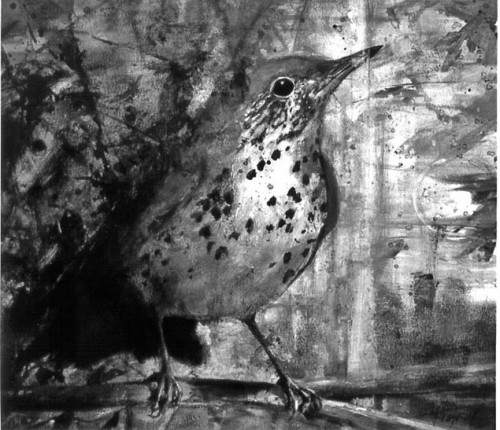
Since the 1960s, the overall number of birds in at least one of our local forests has been declining. Not the number of species, but the total number of birds. This observation comes from long-term research led by Dr. Richard Holmes of Dartmouth College and conducted at the Hubbard Brook Experimental Forest in Woodstock, New Hampshire.
The study is taking place in a 25-acre plot within a larger area of northern hardwood forest on the eastern slopes of Mount Moosilauke. Each breeding season (late May to early July), researchers walk systematically through the plot every day, recording all birds seen or heard, plus any evidence of nesting activity. This survey has been conducted every year since 1969, making it the longest-running study of its kind in the Northeast.
Is this decline in bird numbers a cause for alarm? The first and obvious answer is yes, especially if you are a bird enthusiast hoping to glimpse a rare bird or two, but a closer look at the data reveals a more interesting story, with at least two central messages.
First, our region’s forests are constantly changing, which has a big impact on how many birds can live in them at any one time. Second, birds are not all the same, and each species responds to complex environmental factors in different ways; some species may be increasing while others are declining.
Both points are clearly illustrated by the Hubbard Brook research. While first impressions might suggest that 36 years is enough time for a study to establish what is “normal” for a forest, this is not the case. Our forests are still relatively young, and they were even younger when the study began in 1969. Northern New England experienced extensive logging in the late 1800s and early 1900s, meaning that much of our local forest dates to the early 1900s; very little is older than that. Thus, the “intact” forests of the region in the 1960s were recovering from a large disturbance that occurred only 40-60 years earlier.
Population trends for specific bird species reinforce this important fact. For instance, four of the five species that have declined the most in Hubbard Brook over the 36-year period (least flycatcher, wood thrush, American redstart, and Philadelphia vireo) prefer the habitat characteristic of a middle-aged forest. The forests of this study were at just this stage when the study began. The same forests are now almost 40 years older and have changed considerably in their size, composition, and structure, making them less desirable for these four species.
Since the decline of these relatively few species accounts for a large part of the overall bird decline at Hubbard Brook, what at first glance seems alarming could simply reflect the natural aging of the forest. In fact, over the last 36 years, the populations of several species have slightly increased as the forest has aged – especially the black-throated green warbler, the ovenbird, and the yellow-rumped warbler – while the populations of many others have remained more or less constant.
But while the aging of the forest explains why some birds that were abundant in the beginning of the study have decreased in number since then, it doesn’t explain why new species have not moved in, or why populations of existing species have not increased. Because the species that decreased were not, by and large, replaced by others, the forest now, in 2005, is supporting only about 37 percent of the number of birds it did 36 years ago.
While this decline could be normal for an older forest, it is also possible that some broader environmental changes are at work. In the breeding grounds of our region, for example, factors such as fluctuating caterpillar populations (a major food source) and chipmunk and squirrel populations (major nest predators) clearly affect the yearly reproductive success of some birds. These factors, in turn, are linked to broader changes in climate and vegetation, both of which affect the forest at Hubbard Brook.
Since many of the birds in our northeastern forests are migratory, their populations face human-related pressures in their wintering grounds and migratory routes as well. Bird habitat is being lost to development both in the tropics and in the migratory corridor connecting the breeding and wintering grounds. Sorting out the relative importance of these global population pressures is essential to understanding what is happening locally.
With two-thirds of the birds gone from Hubbard Brook, biologists are working to understand what is attributable to forest succession and what is coming from more human-induced, and human-correctable, factors such as climate change, habitat loss, and acid precipitation. Is the forest of Hubbard Brook unusual? Or is it representative of forests across the wider region? Answering these complex questions will inspire Richard Holmes and the researchers at Hubbard Brook for years to come.

